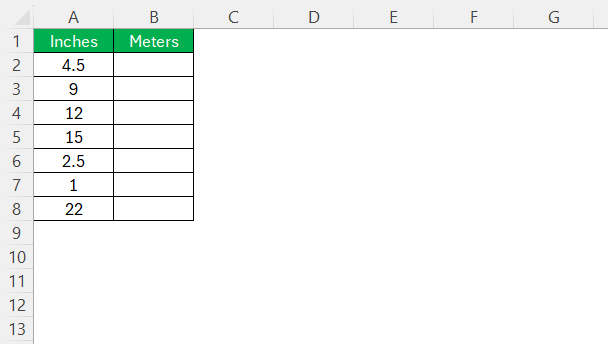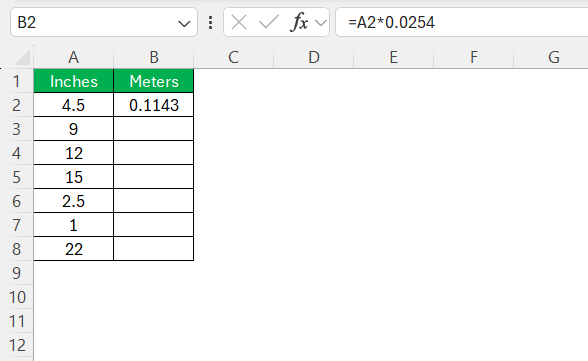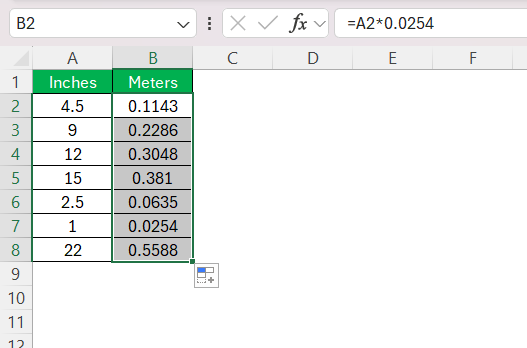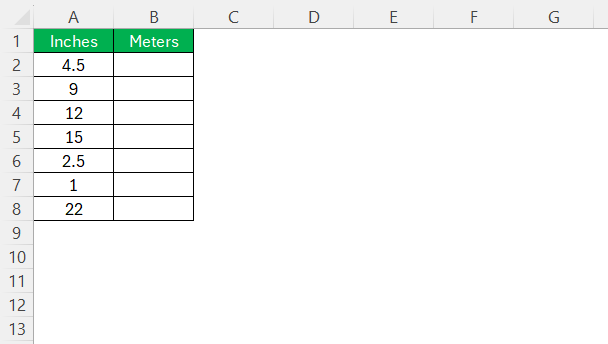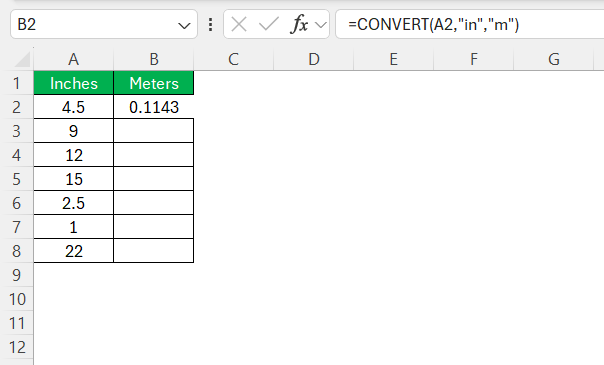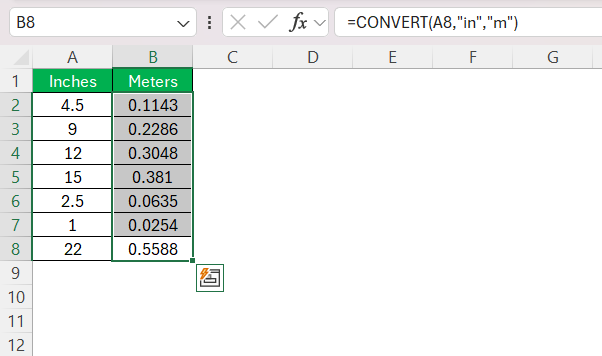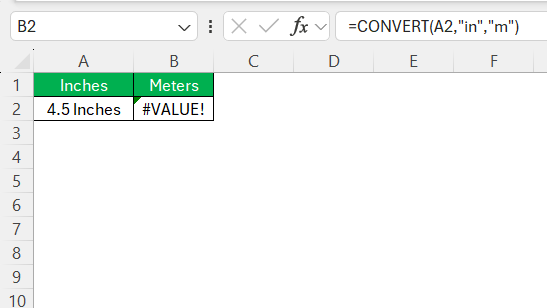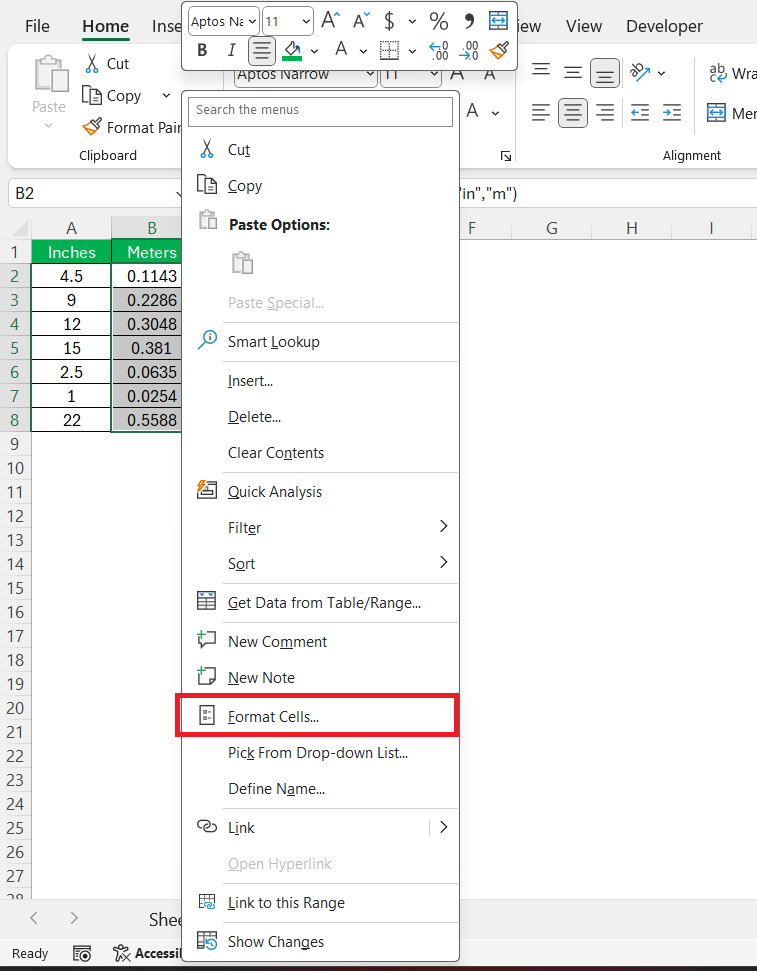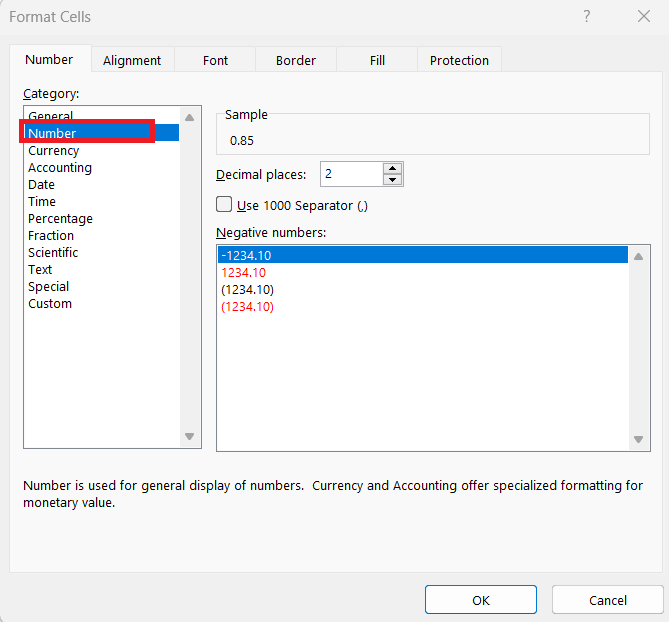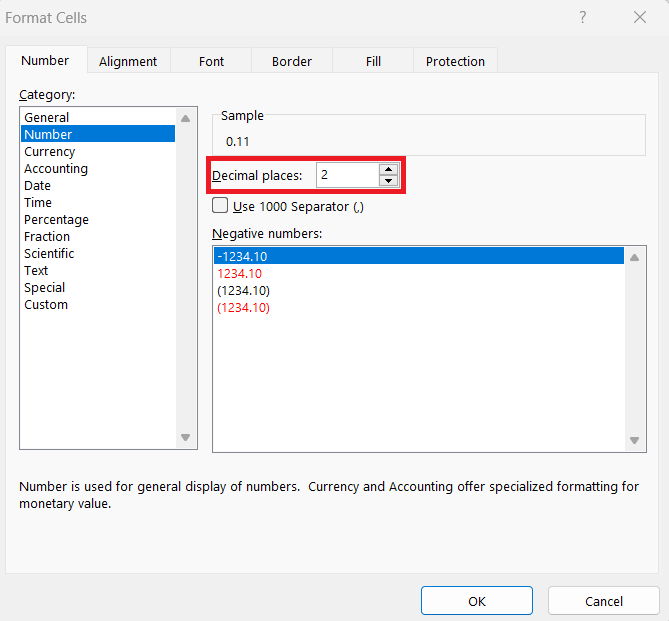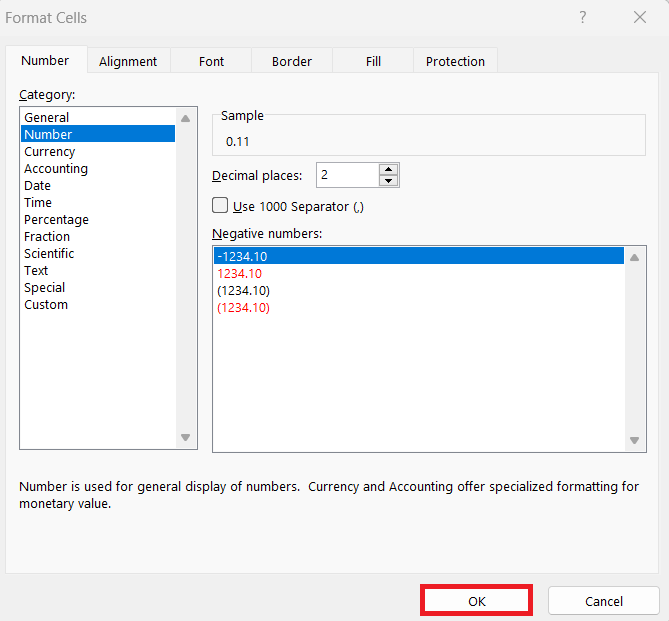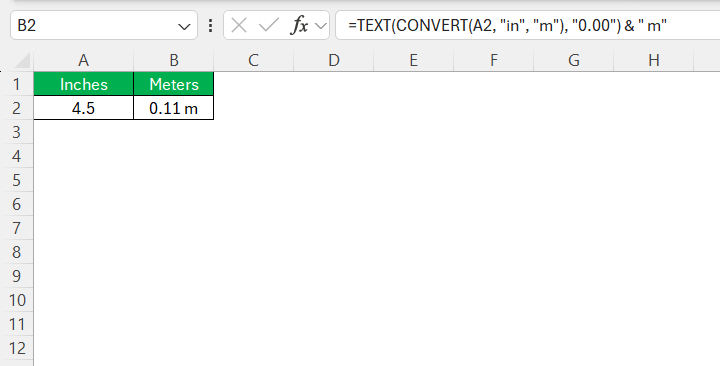When working on projects involving measurements, I often need to switch between different units. One conversion I frequently encounter is converting inches to meters, especially when collaborating with international teams or handling specifications in the metric system.
Thankfully, Excel makes this task straightforward with the CONVERT function. Let me walk you through the process of converting inches to meters in Excel.
Key Takeaways:
- Use the CONVERT Function: Excel’s CONVERT function simplifies unit conversions, taking the number, source unit, and target unit as inputs.
- Syntax Matters: For inches to meters, the formula is
=CONVERT(number, "in", "m"). Unit strings must be precise and case-sensitive. - Formula Builder Helps: Excel’s Formula Builder can guide you through the process, reducing the risk of syntax errors.
- Error Troubleshooting: Common errors like
#N/Aor#VALUE!often stem from incorrect unit strings or invalid inputs. Double-check your entries. - Enhance Readability: Format results with fewer decimal places or use the TEXT function to display results clearly with unit labels.
Table of Contents
Introduction to Unit Conversion in Excel
Understanding the CONVERT Function
Excel is not only a powerful tool for crunching numbers but also for converting units from one measurement system to another. The CONVERT function is a hidden gem within Excel that allows users to seamlessly change units without the need for manual conversion tables or calculators.
This function takes three arguments: the number to convert, the unit you are converting from, and the unit you are converting to.
Why Inches to Meters Conversion is Useful
Converting inches to meters is particularly useful for professionals and students who frequently work with international projects or studies where measurement units vary. Since the metric system is more universally adopted outside of the United States, having the ability to quickly convert measurements to meters can save time and prevent errors when interpreting design specifications, scientific data, or any other documentation where precision is key.
Moreover, inches to meters conversion is indispensable in industries like manufacturing, engineering, and construction, where materials need to adhere to specific dimensions, and accurate conversion ensures compatibility and integrity of structures or components.
Step-by-Step Excel Convert Function Tutorial
Method 1: Using a Simple Formula
The conversion factor between inches and meters is straightforward: 1 inch = 0.0254 meters. To apply this in Excel, follow the steps below –
STEP 1: Start by entering your values in inches into a column. For example:
STEP 2: In the next column (let’s say column B), label it “Meters.” Then, enter this formula in the first cell of column B (e.g., B2):
=A2*0.0254
STEP 3: Drag the fill handle (a small square at the bottom-right corner of the selected cell) down to apply the formula to the rest of the rows in your column.
Method 2: Using the CONVERT Function
Excel also provides a dedicated function called CONVERT that simplifies unit conversions. Here’s how you can use it:
STEP 1: Just like before, enter your values in inches into a column.
STEP 2: In the adjacent column, use this formula to convert inches to meters:
=CONVERT(A2,”in”,”m”)
A2is the cell containing the value in inches."in"is the abbreviation for inches."m"is the abbreviation for meters.
STEP 3: Drag the formula down to convert all the values in the column.
You’ll get the same results as the previous method, but using Excel’s CONVERT function adds clarity to your formula.
Practical Applications and Tips
Common Usage Scenarios for Inches to Meters Conversion
Inches to meters conversion is frequently encountered in various situations. Architects and builders often need it when working with construction plans initially designed with imperial units but need adaptation for a metric-based system. Scientific researchers might also use this conversion for documenting experiments or publishing papers where standard units are required.
Additionally, educators and students, from elementary to university level, engage with this conversion as part of curriculum exercises, particularly in STEM (Science, Technology, Engineering, and Mathematics) education. Retail businesses might convert product sizes for an international clientele, bridging the gap between different measurement standards.
Troubleshooting Common Errors with the Convert Function
When working with the CONVERT function, you might encounter some errors. If you see a #N/A error, check your unit strings; it often means that either the from_unit or the to_unit is unrecognized or that the units are incompatible. The #VALUE! error usually pops up if the number argument is not a valid numeric value or is left empty.
To troubleshoot, first, double-check that you’ve entered the correct unit abbreviations and that they are in quotation marks. Ensure that the units are compatible (for instance, you can’t convert from inches to pounds). If you’re confident the argument syntax is correct, look for any cell references that might be causing the error and verify their values.
Remember, the CONVERT function is case-sensitive, which is a potential pitfall for many users. Hence, always use the correct case for unit strings (e.g., “m” for meters, not “M”).
Enhancing Your Worksheets
Formatting Results for Better Readability
The presentation of data can significantly impact its understandability. When you’re displaying converted measurements in your worksheet, rounding the results can make your data cleaner and more readable. To achieve this, you can format the cell to show a limited number of decimal places. Here’s how:
STEP 1: Right-click on the cell with the conversion result and select ‘Format Cells.’
STEP 2: In the Format Cells dialog box, go to the ‘Number’ tab. Choose ‘Number’ from the category list.
STEP 3: Specify your desired number of decimal places. For instance, choose 2 to display the meters value up to two decimal places for better readability.
STEP 4: Click ‘OK’ to apply the formatting.
Additionally, consider using the TEXT function to concatenate the converted result with a unit abbreviation for clarity. For example: =TEXT(CONVERT(10, "in", "m"), "0.00") & " m".
FAQs: Demystifying Convert Function Queries
What is the CONVERT function in Excel?
The CONVERT function allows you to change a value from one unit of measurement to another. It requires three inputs: the number to convert, the unit to convert from, and the unit to convert to.
How do I convert inches to meters in Excel using the CONVERT function?
To convert inches to meters in Excel, enter the formula =CONVERT(number, "in", "m") into a cell, replacing number with the value in inches you want to convert. For instance, to convert 5 inches to meters, type =CONVERT(5, "in", "m"), and it will provide the result in meters.
What other units can be converted using the Excel CONVERT function?
The Excel CONVERT function can handle conversions between a multitude of units, including length (e.g., feet to meters), weight (e.g., pounds to kilograms), temperature (e.g., Fahrenheit to Celsius), volume (e.g., gallons to liters), and even energy, time, power, and pressure units, among others. This makes the CONVERT function a versatile tool for professionals across various industries, including science, engineering, and education.
Why does the CONVERT function show errors like #N/A or #VALUE!?
A #N/A error occurs if the units are incompatible or misspelled, while a #VALUE! error appears if the number is invalid. Double-check your syntax and ensure the units are case-sensitive and correctly entered.
How can I format converted results for better readability?
Right-click the cell, select “Format Cells,” and adjust the decimal places under the “Number” tab. You can also use the TEXT function to combine the result with a unit label, e.g., =TEXT(CONVERT(10, "in", "m"), "0.00") & " m".
John Michaloudis is a former accountant and finance analyst at General Electric, a Microsoft MVP since 2020, an Amazon #1 bestselling author of 4 Microsoft Excel books and teacher of Microsoft Excel & Office over at his flagship MyExcelOnline Academy Online Course.

